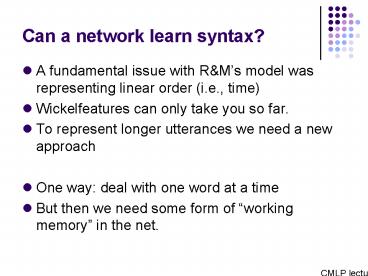Can a network learn syntax - PowerPoint PPT Presentation
1 / 13
Title:
Can a network learn syntax
Description:
Can a network learn syntax? A fundamental issue with R&M's ... the, piano, played, dropped, on, floor, toe, carol, his, her, cat, in, room, she, with, custard, ... – PowerPoint PPT presentation
Number of Views:43
Avg rating:3.0/5.0
Title: Can a network learn syntax
1
Can a network learn syntax?
- A fundamental issue with RMs model was
representing linear order (i.e., time) - Wickelfeatures can only take you so far.
- To represent longer utterances we need a new
approach - One way deal with one word at a time
- But then we need some form of working memory in
the net.
CMLP lecture 6
2
Representing time
- Lets imagine that we presented words one at a
time to a net - With a normal network would it matter which order
the words were given? - No. Each word is a brand-new experience
- The network needs some way of relating each
experience with what has gone before - Intuitively, each word needs to be presented
along with what the network was thinking about
when it heard the previous word.
3
The Simple Recurrent Net (SRN)
Output
Copy back connections
Hidden
Input
Context
- At each time step, the input is
- a new experience
- plus a copy of the hidden unit activations at the
last time step
4
What inputs and outputs should the SRN be given?
- Elman wanted a task that would force the network
to learn syntactic relations - In order to be realistic, need a task without an
external teacher - Use a next word prediction task
- INPUTS Current word ( context)
- OUTPUTS Predicted next word
- Error signal is implicit in the data.
5
Predicting the next word
- Imagine you knew only these words
- the, piano, played, dropped, on, floor, toe,
carol, his, her, cat, in, room, she, with,
custard, ? - What words do you predict will follow
- You can do better than chance because you know
syntax
?
carol
dropped
her
cat
on
the
floor
in
the
room
with
the
piano
?
6
Long distance dependencies and hierarchy
- Elmans question how much is innate?
- Many argue
- Long-distances dependencies and hierarchical
embedding are unlearnable without innate
language faculty - How well can an SRN learn them?
- Test with a toy grammar
- Examples
- boys who chase dogs see girls
- cats chase dogs
- dogs see boys who cats who mary feeds chase
- mary walks
7
First experiments
- Each word encoded as a single unit on in the
input.
8
Initial results
- How can we tell if the net has learned syntax?
- Check whether it predicts the correct number
agreement - Gets some things right, but makes many mistakes
boys who girl chase see dog
- Seems not to have learned long-distance
dependency.
9
Incremental input
- Elman tried teaching the network in stages
- Five stages
- 10,000 simple sentences (x 5)
- 7,500 simple 2,500 complex (x 5)
- 5,000 simple 5,000 complex (x 5)
- 2,500 simple 7,500 complex (x 5)
- 10,000 complex sentences (x 5)
- Surprisingly, this training regime lead to
success!
10
Is this realistic?
- Elman reasons that this is in some ways like
childrens behaviour - Children seem to learn to produce simple
sentences first - Is this a reasonable suggestion?
- Where is the incremental input coming from?
- Similar problem to RM
- Developmental schedule appears to be a product of
changing the input.
11
Another route to incremental learning
- Rather than the experimenter selecting simple,
then complex sentences, could the network? - Childrens data isnt changing children are
changing - Elman gets the network to change throughout its
life - What is a reasonable way for the network to
change? - One possibility memory
12
Reducing the attention span of a network
- Destroy memory by setting context nodes to 0.5
- Five stages of learning (with both simple and
complex sentences) - Memory blanked every 3-4 words (x 12)
- Memory blanked every 4-5 words (x 5)
- Memory blanked every 5-6 words (x 5)
- Memory blanked every 6-7 words (x 5)
- No memory limitations (x 5)
- The network learned the task.
13
Counter-intuitive conclusion starting small
- A fully-functioning network cannot learn syntax.
- A network that is initially limited (but matures)
learns well. - This seems a strange result, suggesting that
networks arent good models of language learning
after all - On the other hand
- Children mature during learning
- Infancy in humans is prolonged relative to other
species - Ultimate language ability seems to be related to
how early learning starts - i.e., there is a critical period for language
acquisition.































